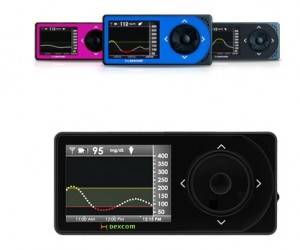 The Dexcom G4 receiver
The Dexcom G4 receiver
Continuous glucose monitors are right now a good tool for a certain subset of people with diabetes, but there's still a majority of people, especially with Type 2 diabetes, for whom fingerstick glucometers are still the cheaper, more convenient option. Dexcom wants to change that.
On a second quarter earnings call, EVP of Strategy and Product Development Steve Pacelli responded to a question about the company's five-year outlook by describing what a Dexcom CGM might look like in 2020.
"Five plus years from now, our goal would be to have a sensor that would be something that's miniaturized, that looks more like a bandage than a medical device, that's fully disposable," he said. "You get it to the point where you overcome basically all of the objections that a patient would have to wearing the device – it talks to your phone, it doesn't have to be calibrated, you don't take fingersticks anymore– there really isn't a reason that you couldn't get very significant penetration into the type 1 market in the US ... I would also add that I think in five years, you're going to see us have very meaningful penetration for sure into the intensive insulin using patients who are type 2s, but I would suggest even potentially even broader into type 2s. So, I think that's going to become an ever-increasing important market segment for us."
For the moment, Dexcom is growing and iterating fast. It posted a Q2 revenue of $93.2 million, up from $58.8 million for the second quarter in 2014, a 59 percent increase. The company launched a new version of Dexcom Share, which allows CGM users and family members to send data to a receiver and from there to a smartphone, at the beginning of the year. Now, the company is awaiting FDA approval for their Generation 5 system, which will eliminate the receiver and send data directly from the CGM to the phone.
"To grow a business this fast, you have to have new thing after new thing after new thing that enhances the patient experience to get deeper into the patient community," Dexcom CEO Kevin Sayer said on the call. "Gen 5 is that next step. We believe the data going straight to a phone will enable patients not to carry an extra thing around in their pocket and will be very helpful. But we also know the next step after that: we have to make it more convenient, we have to eliminate calibrations and the hassle factor, and we have to continue to maintain our excellent level of accuracy. All those things matter, and we address every one of those things every time we iterate."
Also in the company's FDA pipeline: An update to the G4's clearance which would allow the company to claim insulin dosing as a function of the device.
"Initially, I think our belief was that the dosing claim was most important from a Medicare perspective, because Medicare has indicated that until we get the adjunctive labeling removed, that they would not entertain a coverage category for CGM," Pacelli said. But, he added, being FDA-cleared for insulin dosing also has the potential to increase adoption. "This is, again, all anecdotal from our sales force, but these doctors would be much more willing when they don't have to tell their patients that they have to take a confirmatory fingerstick, to prescribe much more. So, I think the dosing claim could actually be a bigger catalyst than maybe we had anticipated in the past."
The company is also finding itself with a lot of new data from Dexcom Share users, and has hired a senior data executive to work on developing a real-time analytics platform to support the sensor. Sayer said the availability of CGM data is also changing how users manage their lives.
"The interesting side note of all the Share data ... is there's a whole new culture that's coming, about how are we going to interact based on CGM," he said. "Because parents are freaking out and calling their kids all the time, then kids turn off their parents from sharing, and adults, you know spouses following each other. We've seen some very interesting text messages between followers and patients. So it's across the board, but clearly the concept is being proven out dramatically."
















